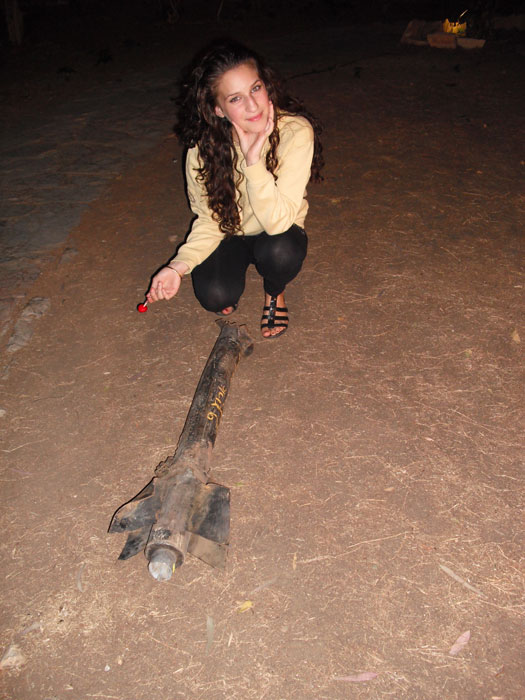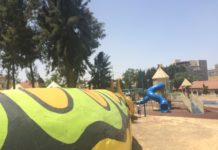In his Poetics, Aristotle suggests that “art imitates life.” This statement is certainly applicable to the Sderot Community Treatment Theatre’s current production, Children of Qassam Avenue, a dramatic reenactment of a dozen teenage girls’ traumatic experiences under the terror of Qassam rockets – which have now been falling on their hometown for the majority of their lives. The company presents an original script jointly written by the artistic director, Livnat Shlessinger, and the group’s psychologist, Debbie Gross, compiling fragments of the girls’ personal stories with the aim of exposing Israeli and international audiences to their plight.
The reverse – “life imitates art” – is also true in this case. As a “treatment theatre,” this yearlong drama therapy programme empowers participants to transfer the skills they develop on stage to their personal, day-to-day handling of the situation. As one participant remarked, the Sderot Treatment Theatre has helped her cope with the harsh reality and regain her joie de vivre.
Aristotle further claims that Tragedy arouses horror and fear, allowing the viewers to purge themselves of those passions. This show not only induces catharsis in the audience, but also in the actors on stage. Even though they have rehearsed their lines numerous times, it is apparent that the performance is having a profound emotional impact on them, each time anew. This aspect makes the show even more meaningful, as the cathartic process affects both parties, demonstrating the power of art to heal those who engage in it. By providing the opportunity for these girls to share their experiences and express their feelings, they are able to sublimate their traumatic emotions and redirect them toward the positive act of art-making. Occasionally, they even manage to evoke laughter, specifically through the role of the Moroccan matriarch, played by Lior Ben Abou.

With very few props and a minimal set, the company manages to capture and convey the girls’ experiences, thanks to their authenticity and sincerity, as well as their intense desire to be liberated from the endless anxiety and pain. The seamless integration of documentary footage into the dramatic scenes transposes the events from Sderot to Jerusalem, bringing them to life. Particularly troubling is the video clip of children in the playground, forced to abandon their games and seek shelter within fifteen seconds.
The recurring recording of the Red Color alert, accompanied by flashing red spotlights, quickly becomes startling, placing the members of the audience in the same delicate position as the residents of Sderot, thus contributing to their identification with the characters on stage. Every time the alarm sounds, the audience members’ heartbeat accelerates and their breathing pauses, in anticipation of the imminent explosion. One then realizes what it means to live in constant fear and to develop traumatic associations with certain colours and sounds. The combined visual and auditory effects envelop the viewer and provide a total sensory experience, offering a reduced taste of life under rocket fire.
Despite the unpleasant occurrences, none of the girls interviewed would agree to leave Sderot, their hometown where they were born and raised. However, a short outing outside of Sderot clearly does them good. It was heartwarming to see the girls running around the theatre garden after the Jerusalem performance, chatting and giggling like normal teenagers. One senses that just several months ago they couldn’t have been as joyful. It appears that the programme has truly enabled them to release tensions bottled up for so long.
When approached, Linoy Shushan, the actress in the lead role, admitted that prior to joining the theatre she had been unwilling to speak of her feelings, but that the programme has opened her up by enabling her to confront and overcome her fears. It was particularly symbolic to capture a final shot of her wearing a red t-shirt and sucking on a red lollipop, kneeling beside a Qassam carcass on the pathway leading up to the theatre, placed there alongside enlarged photographs of collapsed buildings in order to put the audience in the proper mindset, enhancing its receptivity to the story about to unfold before its eyes.
As demonstrated in recent years by other local treatment theatres, such as the Testimony Theatre bringing together Holocaust survivors and third-generation high school students, artistic rendition can raise awareness of and empathy for Israeli suffering better than any documentary means. The Sderot Community Treatment Theatre hopes to perform throughout the country and abroad in order to affect decision-makers as high up as the Knesset and persuade them of the severity of the situation and of the necessity to put an end to such attacks, as well as raise funds to ensure the continuation of this admirable programme.












Thank you for such excellent and well written article. Further to its informative aspect, it succeeded to genuinely transmit to the readers the real emotions of the kids who suffered a lot from the Qassams.